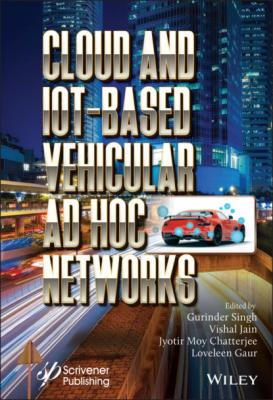Cloud and IoT-Based Vehicular Ad Hoc Networks. Группа авторов
Чтение книги онлайн.
Читать онлайн книгу Cloud and IoT-Based Vehicular Ad Hoc Networks - Группа авторов страница 20
 5G-VANET milieu uses New Radio (NR) air interface which affords more responsive and faster vehicle broadband service.
5G-VANET milieu uses New Radio (NR) air interface which affords more responsive and faster vehicle broadband service.
The 5G-VANET milieu relies on ubiquitous ultra-broadband network architecture, which affords the ultra-modern services for everything and everyone [13].
The 5G-VANET milieu uses packet switching techniques which reduce the packet loss.
The 5G-VANET milieu uses both licensed and unlicensed spectrum which affords higher performance and better reliability.
In a 5G-VANET milieu, the low-density parity check code is used for error correction, which is high in speed and affords better performance and throughput.
In a 5G-VANET milieu, WWWW technology is used, which affords fast interactive communication.
The 5G-VANET milieu is User-centric.
The 5G-VANET milieu uses code division multiple access and beam division multiple access which enhances the accessibility and throughput in the service discovery process [8].
The 5G-VANET milieu uses the IP based protocol.
2.3 Service Discovery
Service discovery is the task-based approach that is used for finding the best resources (services) as per the vehicular user requirements. The best services are retrieved based on three modules such as functional module, context module, and non-functional module [14]. The modules are defined as follows:
Functional Module: All the real-time interactions through the vehicular interfaces are comes under the functional modules.
Context Module: Context module includes the context details about the particular vehicle such as location, date, place, time, and so on. The context module (CM) is classified into two types such as direct CM and indirect CM.
Direct CM: The direct CM is the manual collection of information from reliable cars.
Indirect CM: The indirect CM is the automated data acquisition by the sensors.
Context Module Resources: The context module resources are typically divided into three categories are User context module, Network context module, and Environment context module.
User Context Module: The user context module encompasses data that is supposed to be indirectly accessible when the requester communicates with some variables, like identification, position, and desire of the requester. The user context module is divided into three types are vehicular user identification, vehicular user position, and vehicular user desire.
Vehicular User Identification: Vehicular user identification is the method for assigning a specific identification to a vehicle user. This may also contain sensitive details of the customer, such as vehicle model, name, father’s name, date of birth, and so on.
Vehicular User Position: Vehicular user position details which include the vehicle’s location, orientation, altitude, and geographical connections such as, proximity, co-location, and containment.
Vehicular User Desire: Vehicular user desire acquires information about the profile of their vehicular users, which includes the personality, and behavior of the customer.
Network Context Module: The network context module comprises network related information such as maximum throughput, error rate, communication link, and data rate.
Environment Context Module: The environment context module comprises of environment-related information such as place definition, physical and environmental circumstances, and sequence of activities about the milieu.
Non-Functional Module: It is characterized as a combination of many attributes or characteristics of a service, like reliability, capability, cost, durability, security, and robustness [14].
2.4 Service Discovery in 5G-VANET Milieu
As the number of Internet of Vehicle (IOV) users is increasing the demand for retrieving the precision and efficient services as per the vehicle user’s requirements also increases. As the VANET milieu is highly dynamic and topology changes occur recurrently, retrieving service with accuracy and efficiency is the decisive issue.
Service discovery is a task that discovers the resources (services) as per the IOV user’s requirements. In a 5G-VANET milieu, the service discovery implementations include the VANET users and service providers.
Service Consumers (SC) or VANET users: Service consumers request for the services.
Service Providers (SP): SP publishes its services in the registry for access to SC.
2.4.1 Service Discovery Methods
The literature distinguished three types of service discovery methods such as,
1 Push-based Service Discovery (PUSD)
2 Pull-based Service Discovery (PLSD)
3 Hybrid-based Service Discovery (HSD)
PUSD: In PUSD, the service provider disseminates the services to all vehicles in the VANET milieu, does not wait for the requests from the VANET users. The PUSD is a proactive mode [15–22].
PLSD: In PLSD, the vehicle user transmits a request towards the service provider to find the specific service. The PLSD is a reactive mode [23–25].
HSD: The HSD uses both the PUSD and PLSD. HSD uses both proactive and reactive mode [26–29]. Table 2.1 depicts the characteristics of service discovery methods.
2.4.2 A Framework of Service Discovery in the 5G-VANET Milieu
Figure 2.2 shows the framework of service discovery in the 5G-VANET milieu. A network layer is incorporated with the service unit and routing unit. The service unit processes the discovery mechanism. The discovery mechanism is the key mechanism in service discovery that discovers the desired services for each vehicle user as per their requirements. The routing unit processes the routing task, such as route discovery and hand-off.
Table 2.1 Characteristics of service discovery methods.
| Characteristics | PUSD | PLSD | HSD |
| Mode | Proactive | Reactive | Proactive and reactive |
| Architecture | Centralized | Centralized | Centralized |
| Routing | Broadcast | On-demand routing | Unicast/Broadcast/ Geocast |
| Mobility |